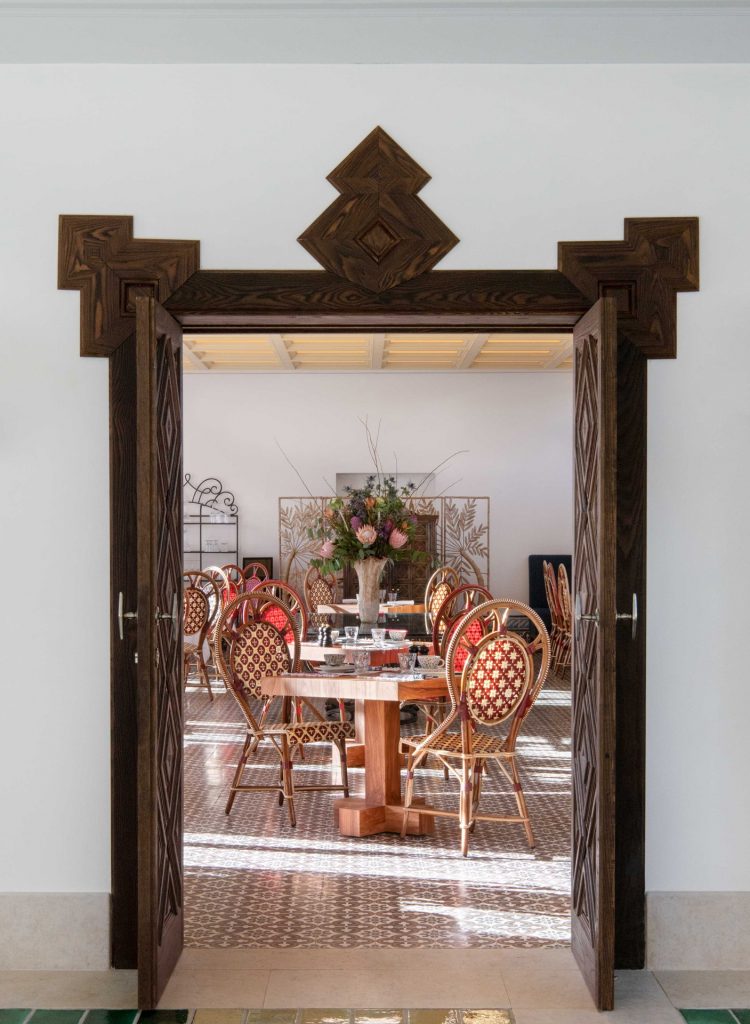SHOEMAKER-TO-THE-STARS CHRISTIAN LOUBOUTIN LENDS HIS SIGNATURE MAXIMALISM TO HIS FIRST-EVER HOTEL PROJECT IN PORTUGAL’S STUNNING ALENTEJO COAST
BY AMANDA McCOY

Portugal’s 93-mile Alentejo coast, stretching from the Tróia Peninsula to the western edge of the Algarve, is a dizzying journey through one of Europe’s most spectacular, yet largely unsung, shorelines. Along the ride, tiny white-washed villages appear between thickets of cork trees, olive groves, hidden coves, jagged cliffs, and golden-sand beaches filled with only the occasional sunbather. Outside of resort-dotted Comporta heralded as the Hamptons of Western Europe most of the region remains primarily untouched by tourism’s golden claws. Melides, for instance, an agriculture community located just 17 miles south of Comporta, boasts the same rugged radiance as its glitzy neighbor but with far fewer crowds. The village of less than 1,500 permanent residents caught the eye of Christian Louboutin in the early aughts, and the Parisian designer purchased a compound on a secluded waterfront stretch on the outskirts of town.

Today, that compound rests on 350 acres and spans eight single-story cottages, all dressed in Christian’s signature color and eccentricity, plus a 28-foot-tall concrete tower outfitted with multicolor-changing LED lights. Every April, Louboutin’s winter collection is born here, with one of the cottages serving as an atelier. (This is where he personally signs the soles of his famed stilettos.) Opening the door to any of the eight buildings is like uncorking a treasure chest of antiques and curios: a taxidermy tiger here, Chinese marble coffee table there. The designer said in an interview with the New York Times that he’ll acquire a rare collectible to hold in storage on the chance he’ll have a space for it later. (“Don’t think about where you’re going to put it, because you probably don’t have a place,” he said.) He’s as much a collector as he is a creator, inspired by color, beauty, and shape. And while he regularly hosts friends and family in his whimsical beach compound, just last year, he extended the invitation to the rest of the world with the launch of his first hotel, Vermelho.

Louboutin tapped his close friend, Portuguese architect Madalena Caiado, to lead the design of the 13-room boutique property. The exterior features a collection of interconnecting buildings rendered in traditional Portuguese style white and powder blue walls, intricate window detailing, terracotta tiled roofs, and chimneys with a few Louboutin-inspired touches, like contrasting cherry red doors and window casings. (The hotel’s name, Vermelho, means red in Portuguese.

Inside, the décor is all Loub, mostly curated by the designer himself from his personal archives pieces that, according to the designer, have been patiently awaiting their moment in the sun. A series of frescoes, antique furniture, local artwork, and azulejo (14th century Portuguese tile) are prevalent throughout, painting an eclectic, richly hued scene that feels more guesthouse than hotel. In fact, at one point during construction, the designer was unsure he would receive the proper approvals from the city, thus he decorated the interiors as he would if it were his private property.

Each of the 13 rooms has its own distinct f lair. They are divided into three types: Double Vista Verde (with and without terraces), Vermelho Junior Suites, and Jardim Portuguese, plus the one-of-a-kind Matinha Suite. In each accommodation, carved wooden doors open to a mosaic of Iberian and greater European artistry, filled with materials, textiles, and furniture from the owner’s personal collection. Think handmade lattice wardrobes by Maison Gatti, door knobs from the famed goldsmithery Orfebre Seco in Seville, antique Venetian mirrors, and hand-painted wall murals by Konstantin Kakanias. Bathrooms are spacious and bright, featuring large marble showers and tubs blanketed in jewel- or earth-toned tiles. Additional luxuries include fluffy bathrobes and slippers and Kama Ayurveda toiletries.

The flagship Matinha Suite is a love letter to the Alentejo, spanning 900 square feet and finished with red coffered ceilings, hand painted frescoes, and a massive marble bathroom with multi-colored pastel walls.

Meals are served at Xtian, Vermelho’s signature restaurant open for breakfast, lunch, and dinner. The bistro-style haunt, led by local chef David Abreu, specializes in Portuguese classics with a global spin. Braised ox cheeks are slow cooked in red wine and served with wild mushrooms and carrots, while lamb cutlets are joined by traditional migas, a bread patty with bacon, rosemary jus, and mint sauce. The cod a la Oxtian is a must-try, a plate of crispy tempura codfish drizzled in olive oil. There’s also an impressive selection of local wines and ports to accompany the meal.

The Vermelho bar is a spectacle in its own right, finished with a cherry red azulejo tile floor and corresponding velvet barstools. The bespoke bar is gloriously extravagant, crafted from green marble overlaid with ornate silver paneling from Villareal goldsmiths. Snag a seat at the bar or retreat to an amber-tinted couch by the fireplace to sip a Portuguese brandy or house sangria.
French landscape architect Louis Benech (whose impressive resume includes the Palace of Versailles) designed the energizing gardens, rich with organic color and Italian sculpture art. There’s a heated plunge pool for sun worshippers, and plenty of leafy trees to find shade for an afternoon novel or meditation practice.
Rooms begin around $380 per night.
Vermelho Hotel
Melides, Portugal


